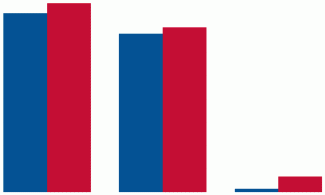This episode was recorded on November 11, 2019.
 Did you know our data library is your centralized hub for up-to-date volume information on test takers, applicants, applications, and more? Tune in as LSAC’s Vice President and Chief of Staff Susan Krinsky highlights some of the reports you can find there, including LSAT Registrant and Test Taker Volumes; Current Volume Summaries by Region, Race/Ethnicity, Gender Identity, and LSAT Score; and Three-Year and Five-Year Volume Graphs. Also learn about the Statistical History Dashboard on ACES and the wealth of data you can access there — including a report showing which candidates have and have not yet completed a writing sample.
Did you know our data library is your centralized hub for up-to-date volume information on test takers, applicants, applications, and more? Tune in as LSAC’s Vice President and Chief of Staff Susan Krinsky highlights some of the reports you can find there, including LSAT Registrant and Test Taker Volumes; Current Volume Summaries by Region, Race/Ethnicity, Gender Identity, and LSAT Score; and Three-Year and Five-Year Volume Graphs. Also learn about the Statistical History Dashboard on ACES and the wealth of data you can access there — including a report showing which candidates have and have not yet completed a writing sample.
Have questions about this podcast, or suggestions for future topics? Submit them to podcast@LSAC.org.
Listen to Podcast #13
Transcript
Hi. This is Susan Krinsky at LSAC with the November edition of Keeping Up to Data.
Today, I’d like to start with some of the reports you can find on LSAC.org in the Data Library. You probably know how to get there — go to LSAC.org, click on Data and Research on the top banner, and then on Data Library. Or, if you are at a member school, log in at the top of the LSAC.org home page, and then click on Data and Research, then Data Library.
The first report you should see is the LSAT Registrant and Test Taker Volumes report. We show the numbers for the current year and the prior year. Before each test administration, the registrant number is updated each evening, so you’ll see that number increase as we near the registration deadline and then decrease as registrants withdraw from that test administration. The final registrant number (and I’d put the word “final” in quotes) is as of midnight the morning of the test. We always see absences from that final registrant number, and those are reflected in the final test-taker number, which isn’t posted until all scores have been released.
That final test taker number reflects the number of individuals who were exposed to the test; it doesn’t reflect canceled scores. Typically, between 4 and 5% of test takers cancel their scores, although the cancellation percentage for this past July test was approximately 50%, not surprising given the one-time opportunity to see scores before deciding whether to cancel.
Twice as many individuals sat for the July 2019 test as compared to July 2018, and we have speculated that a not insignificant number of test takers used the July test as an opportunity to see what the test was like. That half of them canceled their scores brings the number of reportable scores for July 2019 very close to the number of reportable scores for July 2018.
The next report on the Data Library page is the Current Volume Summaries. As of this recording, applications to ABA law schools are up 1.6% over last year and up 9.8% over the applications received at this point two years ago. Applicants to ABA law schools are down 2.6% as compared to a year ago, but up 8.9% as compared to two years ago. The Canadian law schools are currently showing an 11.4% decrease in applications and a 26.8% decrease in applicants.
Remember that the volume data in these reports is available by Region, Race/Ethnicity, Gender Identity, and LSAT Score. Do be aware that the year-over-year data in the Current Volume Summaries is day to day (that is, day of the week), and not date to date. This is noted at the top of each page.
The third report I want to highlight in the Data Library is the Three- and Five-Year Volume graphs. These graphs show you week-by-week volumes of applicants and applications, comparing, for example, November 7 of this year to November 7 of last year.
Also remember the Statistical History Dashboard on ACES. Go to the ACES home page and under Reports, click on Statistical History Dashboard. The page will open to Decision/Current Status for your applicants and provides five years of data. You will see your applicants sorted by Export Decision, Current Status, Decision, Ethnicity, Gender, and LSAT and GPA.
By clicking on almost any cell on that page, you can see narrower groupings. Click on the filter icon in the upper left and you can filter by term, type of applicant, applicant status, and several other categories. Click on the menu icon in the upper left and you’ll see several other options, including a report by residency, also filterable, and a report that shows which candidates have and have not completed a writing sample.
That’s all for this month’s podcast. As always, we’d love to hear from you with questions or suggestions. Just write to us at podcast@LSAC.org. Thanks for listening. Until next time, this is Susan Krinsky at LSAC.
